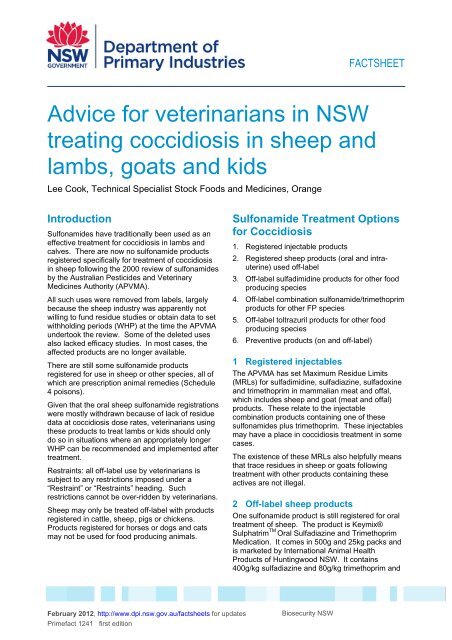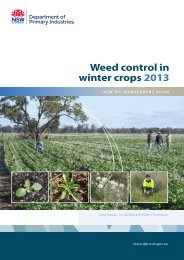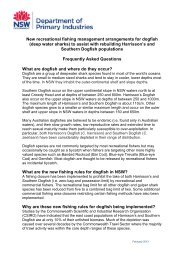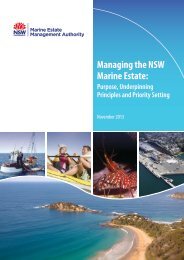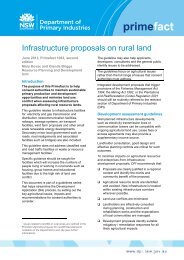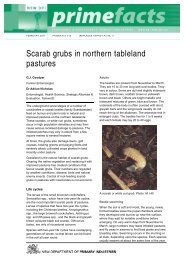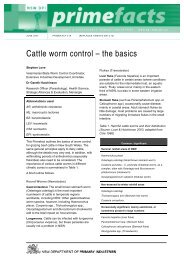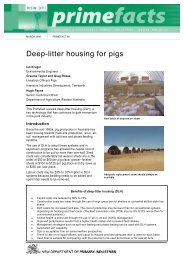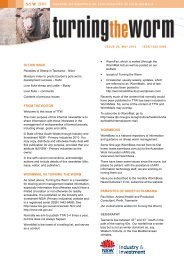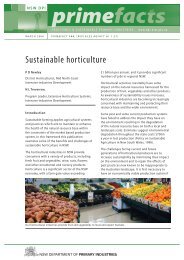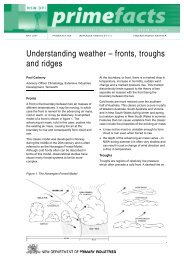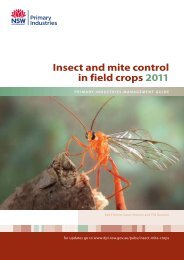Advice for veterinarians in NSW treating coccidiosis in sheep and ...
Advice for veterinarians in NSW treating coccidiosis in sheep and ...
Advice for veterinarians in NSW treating coccidiosis in sheep and ...
You also want an ePaper? Increase the reach of your titles
YUMPU automatically turns print PDFs into web optimized ePapers that Google loves.
FACTSHEET<br />
<strong>Advice</strong> <strong>for</strong> <strong>veter<strong>in</strong>arians</strong> <strong>in</strong> <strong>NSW</strong><br />
treat<strong>in</strong>g <strong>coccidiosis</strong> <strong>in</strong> <strong>sheep</strong> <strong>and</strong><br />
lambs, goats <strong>and</strong> kids<br />
Lee Cook, Technical Specialist Stock Foods <strong>and</strong> Medic<strong>in</strong>es, Orange<br />
Introduction<br />
Sulfonamides have traditionally been used as an<br />
effective treatment <strong>for</strong> <strong>coccidiosis</strong> <strong>in</strong> lambs <strong>and</strong><br />
calves. There are now no sulfonamide products<br />
registered specifically <strong>for</strong> treatment of <strong>coccidiosis</strong><br />
<strong>in</strong> <strong>sheep</strong> follow<strong>in</strong>g the 2000 review of sulfonamides<br />
by the Australian Pesticides <strong>and</strong> Veter<strong>in</strong>ary<br />
Medic<strong>in</strong>es Authority (APVMA).<br />
All such uses were removed from labels, largely<br />
because the <strong>sheep</strong> <strong>in</strong>dustry was apparently not<br />
will<strong>in</strong>g to fund residue studies or obta<strong>in</strong> data to set<br />
withhold<strong>in</strong>g periods (WHP) at the time the APVMA<br />
undertook the review. Some of the deleted uses<br />
also lacked efficacy studies. In most cases, the<br />
affected products are no longer available.<br />
There are still some sulfonamide products<br />
registered <strong>for</strong> use <strong>in</strong> <strong>sheep</strong> or other species, all of<br />
which are prescription animal remedies (Schedule<br />
4 poisons).<br />
Given that the oral <strong>sheep</strong> sulfonamide registrations<br />
were mostly withdrawn because of lack of residue<br />
data at <strong>coccidiosis</strong> dose rates, <strong>veter<strong>in</strong>arians</strong> us<strong>in</strong>g<br />
these products to treat lambs or kids should only<br />
do so <strong>in</strong> situations where an appropriately longer<br />
WHP can be recommended <strong>and</strong> implemented after<br />
treatment.<br />
Restra<strong>in</strong>ts: all off-label use by <strong>veter<strong>in</strong>arians</strong> is<br />
subject to any restrictions imposed under a<br />
“Restra<strong>in</strong>t” or “Restra<strong>in</strong>ts” head<strong>in</strong>g. Such<br />
restrictions cannot be over-ridden by <strong>veter<strong>in</strong>arians</strong>.<br />
Sheep may only be treated off-label with products<br />
registered <strong>in</strong> cattle, <strong>sheep</strong>, pigs or chickens.<br />
Products registered <strong>for</strong> horses or dogs <strong>and</strong> cats<br />
may not be used <strong>for</strong> food produc<strong>in</strong>g animals.<br />
February 2012, http://www.dpi.nsw.gov.au/factsheets <strong>for</strong> updates<br />
Primefact 1241 first edition<br />
Sulfonamide Treatment Options<br />
<strong>for</strong> Coccidiosis<br />
1. Registered <strong>in</strong>jectable products<br />
2. Registered <strong>sheep</strong> products (oral <strong>and</strong> <strong>in</strong>trauter<strong>in</strong>e)<br />
used off-label<br />
3. Off-label sulfadimid<strong>in</strong>e products <strong>for</strong> other food<br />
produc<strong>in</strong>g species<br />
4. Off-label comb<strong>in</strong>ation sulfonamide/trimethoprim<br />
products <strong>for</strong> other FP species<br />
5. Off-label toltrazuril products <strong>for</strong> other food<br />
produc<strong>in</strong>g species<br />
6. Preventive products (on <strong>and</strong> off-label)<br />
1 Registered <strong>in</strong>jectables<br />
The APVMA has set Maximum Residue Limits<br />
(MRLs) <strong>for</strong> sulfadimid<strong>in</strong>e, sulfadiaz<strong>in</strong>e, sulfadox<strong>in</strong>e<br />
<strong>and</strong> trimethoprim <strong>in</strong> mammalian meat <strong>and</strong> offal,<br />
which <strong>in</strong>cludes <strong>sheep</strong> <strong>and</strong> goat (meat <strong>and</strong> offal)<br />
products. These relate to the <strong>in</strong>jectable<br />
comb<strong>in</strong>ation products conta<strong>in</strong><strong>in</strong>g one of these<br />
sulfonamides plus trimethoprim. These <strong>in</strong>jectables<br />
may have a place <strong>in</strong> <strong>coccidiosis</strong> treatment <strong>in</strong> some<br />
cases.<br />
The existence of these MRLs also helpfully means<br />
that trace residues <strong>in</strong> <strong>sheep</strong> or goats follow<strong>in</strong>g<br />
treatment with other products conta<strong>in</strong><strong>in</strong>g these<br />
actives are not illegal.<br />
2 Off-label <strong>sheep</strong> products<br />
One sulfonamide product is still registered <strong>for</strong> oral<br />
treatment of <strong>sheep</strong>. The product is Keymix®<br />
Sulphatrim TM Oral Sulfadiaz<strong>in</strong>e <strong>and</strong> Trimethoprim<br />
Medication. It comes <strong>in</strong> 500g <strong>and</strong> 25kg packs <strong>and</strong><br />
is marketed by International Animal Health<br />
Products of Hunt<strong>in</strong>gwood <strong>NSW</strong>. It conta<strong>in</strong>s<br />
400g/kg sulfadiaz<strong>in</strong>e <strong>and</strong> 80g/kg trimethoprim <strong>and</strong><br />
Biosecurity <strong>NSW</strong>
is registered <strong>for</strong> treatment of bacterial <strong>in</strong>fections <strong>in</strong><br />
<strong>sheep</strong> at a dose of 62.5mg product / kg<br />
bodyweight. For the sulfadiaz<strong>in</strong>e this dose rate<br />
works out at 250mg /10 kg bodyweight, which is<br />
the lower range of those recommended <strong>for</strong><br />
<strong>coccidiosis</strong> treatment (see below). MRLs exist <strong>in</strong><br />
<strong>sheep</strong> tissues <strong>for</strong> sulfadiaz<strong>in</strong>e <strong>and</strong> trimethoprim,<br />
thus reduc<strong>in</strong>g the problem of residues. The label<br />
WHP at this dose is 14 days. This product could<br />
be used off-label to treat <strong>coccidiosis</strong>.<br />
Please note that this product is only manufactured<br />
to order <strong>and</strong> may not be readily available. Stocks<br />
could be purchased <strong>in</strong> advance of anticipated<br />
needs.<br />
Although there are two products, registered as<br />
<strong>in</strong>tra-uter<strong>in</strong>e treatments <strong>for</strong> <strong>sheep</strong> but <strong>for</strong> oral<br />
treatments <strong>in</strong> other species, these appear to no<br />
longer be available (as at February 2012).<br />
The first, Trimaz<strong>in</strong>e Bolus A Sulphonamide<br />
Trimethoprim Preparation (<strong>in</strong> packs of 50 tablets<br />
manufactured by Apex Laboratories) conta<strong>in</strong>s<br />
1000mg of sulfadiaz<strong>in</strong>e <strong>and</strong> 200mg of<br />
trimethoprim. The second, VR Tribactral® Duals<br />
antibacterial pessary/bolus (<strong>in</strong> packs of 20 tablets<br />
manufactured by Intervet) conta<strong>in</strong>s the same<br />
actives. They are registered <strong>for</strong> treatment of<br />
uter<strong>in</strong>e <strong>in</strong>fections <strong>in</strong> <strong>sheep</strong> at a dose of one tablet /<br />
40 kg bodyweight (BWt). For the sulfadiaz<strong>in</strong>e this<br />
dose rate works out at 250mg /10 kg BWt, as<br />
above. The label WHP at this dose is 14 days. If<br />
available these products could potentially be used<br />
off-label to treat <strong>coccidiosis</strong> but the relative degree<br />
of absorption follow<strong>in</strong>g their oral use is unknown.<br />
3 Off-label sulfadimid<strong>in</strong>e products <strong>for</strong><br />
other species<br />
Three pure sulfadimid<strong>in</strong>e products are registered<br />
<strong>for</strong> other species, <strong>and</strong> they could also be legally<br />
prescribed by a veter<strong>in</strong>arian to treat <strong>sheep</strong> or goats<br />
off-label <strong>for</strong> <strong>coccidiosis</strong>. MRLs exist <strong>for</strong><br />
mammalian tissues <strong>for</strong> sulfadimid<strong>in</strong>e, thus reduc<strong>in</strong>g<br />
the problem of residues. There are three products<br />
conta<strong>in</strong><strong>in</strong>g only sulfadimid<strong>in</strong>e:<br />
1. Sulfa FG Premix medication <strong>for</strong> pigs conta<strong>in</strong><strong>in</strong>g<br />
200g/kg sulfadimid<strong>in</strong>e<br />
(<strong>in</strong> 25kg packs from Agribus<strong>in</strong>ess (Lienert) of<br />
Macclesfield, South Australia).<br />
2. SD333 sulfadimid<strong>in</strong>e solution conta<strong>in</strong><strong>in</strong>g<br />
333g/L sulfadimid<strong>in</strong>e<br />
(<strong>in</strong> 500mL bottles from Cattlekare of<br />
D<strong>and</strong>enong, Victoria).<br />
3. CCD Sulfadimid<strong>in</strong>e sodium soluble conta<strong>in</strong><strong>in</strong>g<br />
1000g/kg sulfadimid<strong>in</strong>e<br />
(<strong>in</strong> 1kg <strong>and</strong> 25kg packs from CCD Animal<br />
Health, Girraween, New South Wales).<br />
The second product is similar to the old Coccee<br />
Drench.<br />
One problem the APVMA review found was that<br />
historically recommended dose rates <strong>for</strong> oral<br />
treatment of <strong>coccidiosis</strong> <strong>in</strong> <strong>sheep</strong> with sulfadimid<strong>in</strong>e<br />
have varied markedly. For example:<br />
• 110 mg / kg BWt / day <strong>for</strong> 3 days<br />
(previously registered Coccee solution)<br />
• 25mg / kg BWt daily <strong>for</strong> 7 days<br />
(Veter<strong>in</strong>ary Medic<strong>in</strong>e, Radostits et al)<br />
• 150 mg / kg BWt daily <strong>for</strong> 3 days<br />
(Antimicrobial Prescrib<strong>in</strong>g Guidel<strong>in</strong>es)<br />
• 5-10 mL of 333g/L solution (1665-3330 mg) per<br />
lamb per day (Hunger<strong>for</strong>d).<br />
The current label <strong>for</strong> the Cattlekare product above<br />
has a cattle WHP of 14 days. The (oral) cattle<br />
dose is 740 mg / 10kg BWt <strong>for</strong> three days.<br />
4 Off-label comb<strong>in</strong>ation<br />
sulfonamide/trimethoprim products <strong>for</strong><br />
other species<br />
There are a number of other oral (liquid <strong>and</strong> solid)<br />
sulfonamide products registered <strong>for</strong> other food<br />
produc<strong>in</strong>g species which could also be legally<br />
prescribed by a veter<strong>in</strong>arian to treat <strong>sheep</strong> off-label<br />
<strong>for</strong> <strong>coccidiosis</strong>. These products conta<strong>in</strong> both a<br />
sulfonamide (sulfadimid<strong>in</strong>e <strong>and</strong>/or sulfadiaz<strong>in</strong>e)<br />
<strong>and</strong> trimethoprim. Products <strong>for</strong> calves conta<strong>in</strong><strong>in</strong>g<br />
streptomyc<strong>in</strong> or neomyc<strong>in</strong> are not recommended<br />
as they provide unnecessary antibiotics.<br />
Appropriate WHPs must still be provided by the<br />
prescrib<strong>in</strong>g veter<strong>in</strong>arian.<br />
Example products (this list may not be complete)<br />
<strong>in</strong>clude:<br />
1. GAH Formula Trimethosul Dispersible Powder<br />
conta<strong>in</strong><strong>in</strong>g sulfadiaz<strong>in</strong>e <strong>and</strong> trimethoprim<br />
(<strong>in</strong> ½, 1, 5, 10 <strong>and</strong> 20kg packs).<br />
2. Agrotech Trimethosol<br />
(<strong>in</strong> 500g packs).<br />
3. AFS Trimsul conta<strong>in</strong><strong>in</strong>g sulfadiaz<strong>in</strong>e <strong>and</strong><br />
trimethoprim<br />
(<strong>in</strong> 500 g packs or 500mL solution).<br />
4. Trimetsulpha Water Soluble® conta<strong>in</strong><strong>in</strong>g<br />
sulfadiaz<strong>in</strong>e <strong>and</strong> trimethoprim<br />
(<strong>in</strong> 15 <strong>and</strong> 30kg packs).<br />
5. Trimid<strong>in</strong>e Powder conta<strong>in</strong><strong>in</strong>g sulfadimid<strong>in</strong>e <strong>and</strong><br />
trimethoprim<br />
(<strong>in</strong> 250g packs).<br />
6. Sulprim Oral Powder conta<strong>in</strong><strong>in</strong>g sulfadimid<strong>in</strong>e<br />
<strong>and</strong> trimethoprim<br />
(<strong>in</strong> 250g <strong>and</strong> 1 kg packs).<br />
A literature review <strong>in</strong> 1982 suggested that a s<strong>in</strong>gle<br />
dose of a sulphonamide was as effective as repeat<br />
p 2 <strong>Advice</strong> <strong>for</strong> <strong>veter<strong>in</strong>arians</strong> <strong>in</strong> <strong>NSW</strong> treat<strong>in</strong>g <strong>coccidiosis</strong> <strong>in</strong> <strong>sheep</strong> <strong>and</strong> lambs, goats <strong>and</strong>
doses <strong>in</strong> produc<strong>in</strong>g cl<strong>in</strong>ical recovery (though not <strong>in</strong><br />
reduc<strong>in</strong>g shedd<strong>in</strong>g of oocysts). Dos<strong>in</strong>g with<br />
sulfadimid<strong>in</strong>e at 150 mg/kg Bwt as a s<strong>in</strong>gle dose<br />
has been reported as effective.<br />
(Medication Aga<strong>in</strong>st Ov<strong>in</strong>e Coccidiosis – A Review<br />
Gregory MW, Joyner LP & Catchpole J, Veter<strong>in</strong>ary<br />
Research Communications, 5 (1981/1982) 307-<br />
325).<br />
5 Other Chemical Products - toltrazuril<br />
Toltrazuril is a very effective coccidiostat which has<br />
been registered <strong>for</strong> some time <strong>for</strong> use <strong>in</strong> poultry<br />
<strong>and</strong> more recently <strong>for</strong> use <strong>in</strong> piglets <strong>and</strong> now<br />
calves. In order <strong>for</strong> it to be used <strong>in</strong><br />
lambs/<strong>sheep</strong>/kids there would need to be an<br />
official Maximum Residue Limit (MRL) set <strong>for</strong> the<br />
residues <strong>in</strong> <strong>sheep</strong>/goat tissue <strong>and</strong> no such MRL<br />
exists. Even <strong>in</strong> calves there are still relatively high<br />
residues after the 56 day label WHP but an MRL<br />
has been set to cover this. Only if a prescrib<strong>in</strong>g<br />
veter<strong>in</strong>arian can supply a WHP sufficiently long to<br />
ensure that no detectable residue rema<strong>in</strong>s should<br />
they recommend its use off-label <strong>for</strong> lambs/<strong>sheep</strong><br />
or other meat produc<strong>in</strong>g animals.<br />
An Export Slaughter Interval (ESI) <strong>and</strong> a retreatment<br />
<strong>in</strong>terval of 75 days is provided <strong>for</strong> calves.<br />
Literature references suggest no residues above<br />
the limit of quantification are present by this time <strong>in</strong><br />
calves, but this may not apply to <strong>sheep</strong> or goats.<br />
6 Coccidiosis Prevention<br />
Rumens<strong>in</strong>® 100 (monens<strong>in</strong>) is now registered by<br />
Elanco <strong>for</strong> <strong>coccidiosis</strong> prevention <strong>in</strong> cattle, <strong>sheep</strong><br />
<strong>and</strong> goats, <strong>and</strong> MRLs have been established <strong>for</strong><br />
<strong>sheep</strong>. It is not prescription only.<br />
Bovatec® <strong>and</strong> Avatec ® (lasalocid) products <strong>in</strong><br />
various concentrations <strong>and</strong> pack sizes are<br />
registered by Pfizer <strong>for</strong> add<strong>in</strong>g to <strong>sheep</strong> fed “<strong>in</strong><br />
conf<strong>in</strong>ement” to prevent <strong>coccidiosis</strong>. As a result<br />
MRLs exist <strong>for</strong> use <strong>in</strong> <strong>sheep</strong> (but also meat<br />
mammalian generally).<br />
If <strong>sheep</strong> are at pasture, rather than <strong>in</strong> conf<strong>in</strong>ement,<br />
then lasalocid would strictly require written<br />
directions from a veter<strong>in</strong>arian <strong>for</strong> use while at<br />
pasture, s<strong>in</strong>ce the use would be off-label.<br />
Off-label use of monens<strong>in</strong> or lasalocid as a s<strong>in</strong>gle<br />
dose treatment may also be useful but<br />
<strong>veter<strong>in</strong>arians</strong> would have to satisfy themselves<br />
regard<strong>in</strong>g the efficacy <strong>and</strong> residue profile <strong>for</strong> this<br />
use.<br />
Further, most lasalocid products specifically restrict<br />
s<strong>in</strong>gle dose treatments as a label restra<strong>in</strong>t. This<br />
prevents such off-label use by a veter<strong>in</strong>arian.<br />
Off-label Directions<br />
In <strong>NSW</strong>, users who are not <strong>veter<strong>in</strong>arians</strong> must<br />
follow the label directions. Written off-label<br />
directions can be provided to a client by a<br />
veter<strong>in</strong>arian <strong>and</strong> these must <strong>in</strong>clude animal<br />
species, dose rate, frequency of treatment, length<br />
of treatment <strong>and</strong> manner of adm<strong>in</strong>istration, as well<br />
as a WHP. S<strong>in</strong>ce there are no WHPs <strong>for</strong> off-label<br />
uses the period should be equal to, <strong>and</strong> advised to<br />
the potential user as, an ESI. The written<br />
directions must be signed <strong>and</strong> dated by the<br />
direct<strong>in</strong>g veter<strong>in</strong>arian. This is dealt with <strong>in</strong> Sections<br />
39, 39A, 39C <strong>and</strong> 39D of the Stock Medic<strong>in</strong>es Act<br />
1989.<br />
Us<strong>in</strong>g any product off-label is at the discretion of<br />
the prescrib<strong>in</strong>g veter<strong>in</strong>arian. If any problems result<br />
such as treatment failure or illegal residue<br />
detections, the prescrib<strong>in</strong>g veter<strong>in</strong>arian may be<br />
held liable (see Section 40(2) of the Stock<br />
Medic<strong>in</strong>es Act <strong>in</strong> relation to illegal residue issues).<br />
© State of New South Wales through Department of Trade <strong>and</strong><br />
Investment, Regional Infrastructure <strong>and</strong> Services 2012. You<br />
may copy, distribute <strong>and</strong> otherwise freely deal with this<br />
publication <strong>for</strong> any purpose, provided that you attribute the<br />
Department of Trade <strong>and</strong> Investment, Regional Infrastructure<br />
<strong>and</strong> Services as the owner.<br />
ISSN 1832-6668<br />
Disclaimer: The <strong>in</strong><strong>for</strong>mation conta<strong>in</strong>ed <strong>in</strong> this publication is<br />
based on knowledge <strong>and</strong> underst<strong>and</strong><strong>in</strong>g at the time of writ<strong>in</strong>g<br />
(February 2012). However, because of advances <strong>in</strong> knowledge,<br />
users are rem<strong>in</strong>ded of the need to ensure that <strong>in</strong><strong>for</strong>mation upon<br />
which they rely is up to date <strong>and</strong> to check currency of the<br />
<strong>in</strong><strong>for</strong>mation with the appropriate officer of the Department of<br />
Primary Industries or the user’s <strong>in</strong>dependent adviser.<br />
Recognis<strong>in</strong>g that some of the <strong>in</strong><strong>for</strong>mation <strong>in</strong> this document is<br />
provided by third parties, the State of New South Wales, the<br />
author <strong>and</strong> the publisher take no responsibility <strong>for</strong> the accuracy,<br />
currency, reliability <strong>and</strong> correctness of any <strong>in</strong><strong>for</strong>mation <strong>in</strong>cluded<br />
<strong>in</strong> the document provided by third parties.<br />
The product trade names <strong>in</strong> this publication are supplied on the<br />
underst<strong>and</strong><strong>in</strong>g that no preference between equivalent products<br />
is <strong>in</strong>tended <strong>and</strong> that the <strong>in</strong>clusion of a product name does not<br />
imply endorsement by the Department of Primary Industries<br />
over any equivalent product from another manufacturer.<br />
Any decision to treat animals <strong>and</strong> provide WHPs based on<br />
these considerations is made entirely at the decision of the<br />
attend<strong>in</strong>g veter<strong>in</strong>arian. No recommendation is made that any<br />
such use is or will be effective or that it will be safe to either the<br />
animals or humans consum<strong>in</strong>g food produced by treated<br />
animals.<br />
Published by the Department of Primary Industries, a part of the<br />
Department of Trade <strong>and</strong> Investment, Regional Infrastructure<br />
<strong>and</strong> Services.<br />
PUB12/118<br />
<strong>Advice</strong> <strong>for</strong> <strong>veter<strong>in</strong>arians</strong> <strong>in</strong> <strong>NSW</strong> treat<strong>in</strong>g <strong>coccidiosis</strong> <strong>in</strong> <strong>sheep</strong> <strong>and</strong> lambs, goats <strong>and</strong> kids p 3


